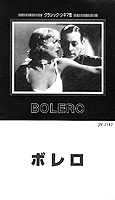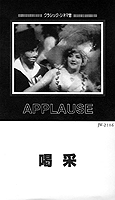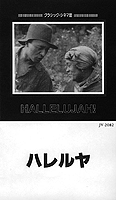
|
|
Apr. 15, 1997 (b)
|
Column Index - Apr. 15, 1997
![]()

Video
"Bolero"
"Applause"(Mamoulian)
"Hallelujah!"
Filmography for Wesley Ruggles
Filmography for George Raft
Carole Lombard -- Comic Genius
Autographics - Carole Lombard
Filmography of Carole Lombard
Mikio NARITA (in Japanese)
Applause(1929)
Filmography for Rouben Mamoulian
Hallelujah(1929)
Filmography for Sergei M. Eisenstein
Filmography for King Vidor
Our Daily Bread(1934)
Silent Movies
Silent Film Sources - Silent Films Availability in the U.S.
Silent Majority
|
The Early Talkie Movies and
When "Bolero" (1934) directed by Wesley Ruggles, which was not even introduced in the United States, was released as video in Japan, I happily had an opportunity to watch it. This film itself was certainly very interesting, but immediately after the fact that the protagonist (American person), played by George Raft, actually had a Belgian nationality, was exposed, I felt that something was wrong. Of course, this "fact" is not something unnecessary as a factor in storytelling. In order to serve in the war as soon as the First World War started, he needed a nationality besides that of the United States. Also, the fact that country was Belgium and not England or France (where he becomes active as a dancer), appropriately functions to create the situation where, on the night when he visited the grave of his mother, he was unwillingly given the same room as Carole Lombard (but willingly at the same time) because English or French could not be used with the landlady of the inn. I felt something wrong because of the suddenness when this element intervened into the narrative immediately before the time of introduction required by the story. Is "Bolero" like a silent movie? Shigehiko HASUMI, who compared this film and the famous "Tsuruhachi Tsurujiro (Tsuruhachi and Tsurujiro)" by Mikio NARUSE, that is said to be the remake of this movie, in the special issue, "Films - (a medium) which regenerates literature", in No. 4, Vol. 42 (March, 1997) of "Kokubungaku: Kaishaku to Kyouzai no Kenkyu", concludes that "rather than the narrative of 'Bolero' which carries the '20's silent-movie-like chaos, 'Tsuruhachi Tsurujiro (Tsuruhachi and Tsurujiro)' is far more like a '30's American movie". However, though he intently refers to the arrangement of the story elements, he also points out that the "chaos" brought into the narrative of a silent movie was due to the "visual elements" on the screen, thus this article titled "Ravel and Shinnai", is slightly confusing for the reader. If we were to think of the remnants of the silent films seen on the screen in the early talkie era of the late '20's to the first half of the '30's, the easiest examples are the complicated optical processes, such as the strangely shaped wipes, and printing of multiple images in one frame. Other examples are face close-ups that seem like a concentration of emotions, as in the scene where the daughter sees her mother's stage for the first time in "Applause" (1929) by Rouben Mamoulian, and in the scene of the black church where the followers all fall into a religious trance-like condition within the movie, "Hallelujah!" (1929), by King Vidor, who later exposes his lean towards Eisenstein in his "Our Daily Bread" (1934). However, a silent-movie like sign that displays a visual nature is lacking in "Bolero" anyway, and we cannot help but say that this is a film "made like a talkie" in terms of the visual too. What is called "silent-movie-like" here, is probably the "style of narrative" meaning the positioning of the story elements seen on the screen. A system achieving "transparency" However, still, this article makes me want to supplement something due to its ambivalence derived from an article that is not an academic thesis (though of course, that is an appeal exclusive to commentaries). HASUMI, who points out that in the narrative of "Bolero", which lacks the "transparency of the film achieved by all the elements effectively functioning", as an example, writes of the slackness in the narrative structure brought about as a result of the relative lateness of Lombard's appearance, but in this case, the cause should be sought rather in the incomplete consideration at the stage of writing the screenplay. The "fact" concerning Raft's nationality, which functions effectively in the story but brings about a strange feeling from its suddenness, was mentioned in the beginning, and this impression also originates probably from the same imperfection. If this film were produced by a production in which the various departments, related to the production process for a constant creation of films above a certain quality standard, had "functioned effectively", it would have been "transparent" like the narrative of "Tsuruhachi Tsurujiro (Tsuruhachi and Tsurujiro)". This means that, rather than the special nature of a "silent movie", the problem relates to the studio system which progressed in Hollywood parallel to the development of talkies. What is exposed in the chaos of "Bolero"'s narrative is the vestiges of the "age before the studio system". [Naoko SHINOGI/Film History, American Culture]
|
|
|
|
|
|
|
|
|
Apr. 15, 1997 (b)
|
[home]/[Art information]/[Art Watch]
Copyright (c) Dai Nippon Printing Co., Ltd. 1997
Network Museum & Magazine Project / nmp@nt.cio.dnp.co.jp


